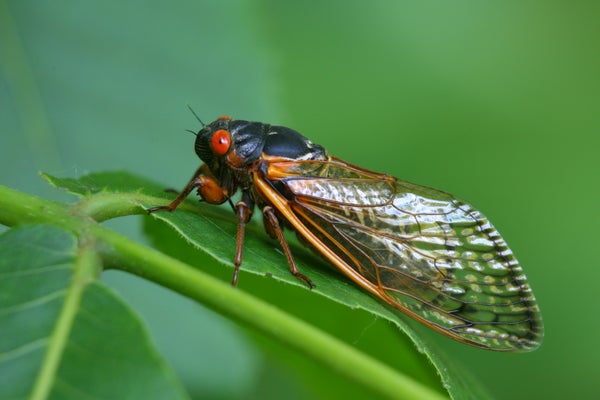When red-eyed cicadasstart crawling out of the ground and up tree branches, they almost always cause a stir. Such events are happening right now in parts of Virginia, West Virginia and North Carolina. The insects’ mating call creates a cacophony of white noise and causes excitement about a phenomenon that is supposed to occur only once every 13 or 17 years.
But there are more than a dozen separate groups of “periodical” cicadasthat appear regularly in the U.S. A different group, or brood, emerges every year in spring. They are simply located in distinct geographical regions. And a few species, known as dog-day or annual cicadas, do not emerge en masse periodically but every year, usually later in the summer.
Some periodical cicada broods appear in the Northeast after spending 17 years underground, growing extremely slowly while feeding on roots and using soil temperature to tune their internal clock. When their designated year comes around, and their surroundings reach 64 degrees Fahrenheit, they start breaking through the dirt. Other 17-year broods live in mid-Atlantic states and the Mississippi Valley, whereas broods that have a 13-year life cycle are largely found in Alabama, Kentucky and Tennessee.
On supporting science journalism
If you're enjoying this article, consider supporting our award-winning journalism by subscribing. By purchasing a subscription you are helping to ensure the future of impactful stories about the discoveries and ideas shaping our world today.
Still, cicada emergence is never perfectly clean: a few membersof broods hatch a year early or a year late—or even four years early or four years late.
.jpg?w=900)
Field observations, as of May 30, by people using the Cicada Safari cell phone app show the puzzling emergence of different cicada broods—on schedule (Brood IX), and early. The app was developed by researchers at Mount St. Joseph University and allows users to photograph or film cicadas and send in the visuals for verification and mapping. Credit: Gene Kritsky and Chris Simon
Scientists think the rare emergences allow periodical cicadas to avoid predators. Even if a few of the insects get eaten by birds, so many remain that they can mate, only to die after successfully starting the next generation. This season’s group, known as Brood IX, was last seen in its region in 2003 and 2004. Parts of the area overlapwith Brood II, which surfaced in 2013. “Cicada emergence is a really amazing biological phenomenon,” says Eric Day, an entomologist at Virginia Tech. “Some places may see a few cicadas; some places have maybe 1,000 coming out per acre. And you have places that have 100,000 or a million insects coming out of the ground every acre.”
The cicadas do not cause much annoyance other than their shrill singing and the crunchy husks they leave behind when they molt, according to Day. Orchard owners know to delay planting new trees to avoid damage from females laying their eggs in branches, he says.
In addition to this year’s Brood IX, entomologists are seeing cicadas from the 17-year Brood XIII emerging four years early around Chicago. Members of the 13-year Brood XIX are also appearing four years early in spots from St. Louis, Mo., to Raleigh, N.C. Citizen scientists logging photographs of the insects at www.magicicada.org and the Cicada Safari app have helped researchers note a few Brood X individuals peeking out one year early around the Washington, D.C. area.
The untimely bugs are much less abundant than those arising in “normal” brood years and tend to die out or get eaten, says Chris Simon, a cicada biologist at the University of Connecticut. Scientists observed early cicadas as far back as 1969, when Henry Dybas of the Field Museum in Chicago recorded the phenomenon. But the nonconformists have remained mysterious: researchers are not sure why some cicadas come out earlier. One possibility is that the individuals develop faster than the rest of their cohort, Simon says. Another theory is that climate events trigger the early advent.
“Presumably at one time, there was just one brood of cicadas, maybe 10,000 years ago or a little less,” Simon says. “That’s when the forests in the U.S. started looking like they do today, after the ice ages ended.” As forest cover decreased and cicadas became reproductively isolated, they formed different broods, eventually splitting into even smaller groups, she says.
With global warming affecting forests, as well as insects, observers may see early cicadas in greater numbers. But it is hard to assess any impacts just yet. “Cicada broods are one big jigsaw puzzle,” Simon says. “We don’t know of any other organism that operates the way they do.”
